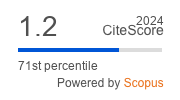Psycholinguistic Features of Religious Discourse (Theoretical Aspect)
Keywords:
psycholinguistics, psycholinguistic peculiarities, religious discourse, comprehension, cognitive theories and models.Abstract
The article deals with the overall specificity of religious discourse as an object of psycholinguistic research. The importance of studying of the relevant scope of communicative and language activities in both the spiritual crisis of our society and in difficult methodological search of national psychology is substantiated. The definition of «religious discourse» in terms of philosophical, theological, sociological and linguistic studies is clarified. A wide range of its significant features, namely the presence of such a participant as «God» (a «super agent»), the intermediaries between God and people (prophets, angels, «saints»); reliance on religious books and religious buildings as the basis of the text and time-space support; basing on the values that are «canned» during several millennia; involvement of specific vocabulary and linguistic phrases; significant symbolism and metaphors; ritualism and absolutization of the meaning of a ritual is singled out.
The need to differentiate such terms as «religious language», «religious style», «religious text» and «religious discourse», as well as various really functioning subtypes of the last («Christian» or «Islamist», «Catholic» or «Orthodox» etc.) with its being the most abstract, generic concept is determined. The basic concepts of psycholinguistics («sign», «language», «knowledge», «cognitive processes», «speech activity», «communication», «comprehension» etc.) are singled out as the theoretical principles of researching a particular religious discourse. The author mentions common semantic models of decoding and comprehension of the information (especially those of communicative nature) and more specific ones, being more important for researching the understanding of the religious discourse, with the cognitive theory of metaphor taken as its example.
References
- Baimuratova, U. (2010). Elementy Religioznogo Diskursa v Khudozhestvennoi Kartine Mira:
Leksicheskyi Aspekt: avtoreferat dissertatsii [Elements of Religious Discourse in Artistic Picture of the
World: Lexical Aspect]. Samara. - Bakhtin, M. (1979). K Metodologii Gumanitarnykh Nauk [The Methodology of the
Humanities]. Moscow: Iskusstvo. - Belyanin, V. (2004). Psikholingvistika [Psycholinguistics]. Moscow: Flinta.
- Bobyreva, Ye. (2008). Religioznyi diskurs: tsennosti i zhanry [Religious discourse: values
and genres]. Knowledge. Understanding. Ability, 1, 162 – 167. - Busel, V. (2005). Velykyi Tlumachnyi Slovnyk Suchasnoii Ukraiinskoii Movy [Explanatory
Dictionary of the Contemporary Ukrainian Language]. Kyiv: Perun. - Chernyshova, Yu. (2012). Religiinyi tekst, styl, dyskurs: utochnennia poniat [Relіgіous text,
style, discourse: clarification of the notions]. Studia Linguistica, 6(2), 361–365. - Druzhynin, V. (2002). Kognitivnaya Psikhologia [Cognitive Psychology]. Moscow: PER SE.
- Garman, M. (1996). Psycholinguistics. Cambridge: Cambridge University Press.
- Gorelov, I. (2001). Osnovy Psikholingvistiki [Fundamentals of Psycholinguistics]. Moscow:
Labirint. - Huber, C. (2000). Speaking of God. Washington, DC: Council for Research in Values and
Philosophy. - Kovshykov, V. (2007). Psikholingvistika. Teoria Rechevoi Deyatelnosti
[Psycholinguistics. The Theory of Speech Activity]. Moscow: AST.







 Creative Commons «Attribution» 4.0
Creative Commons «Attribution» 4.0